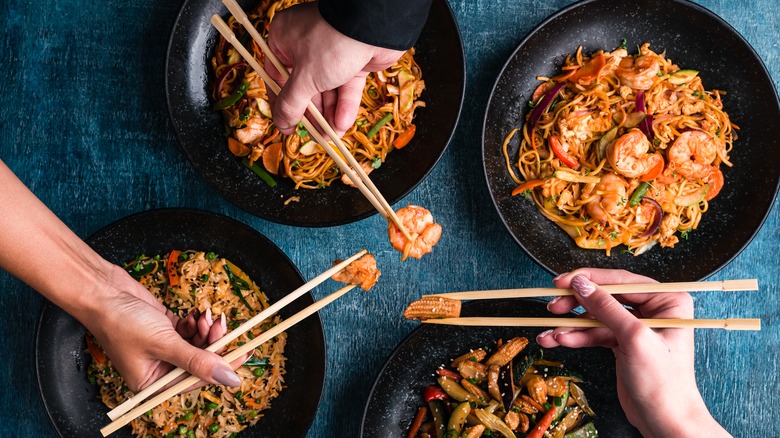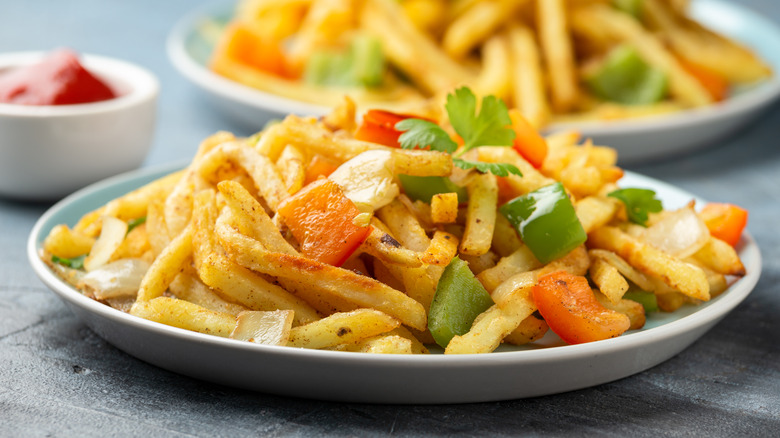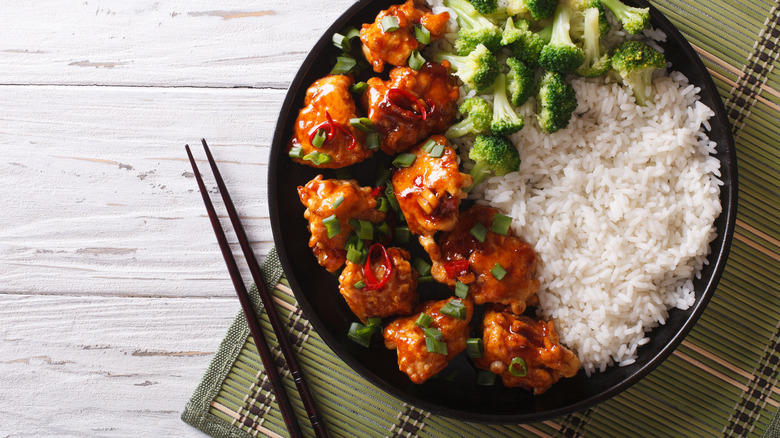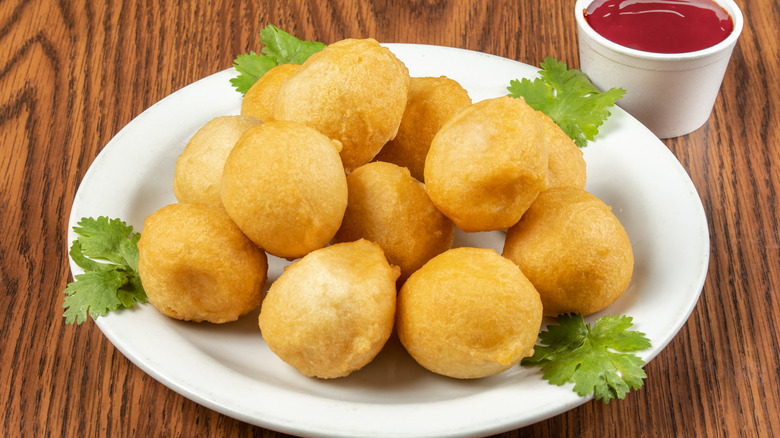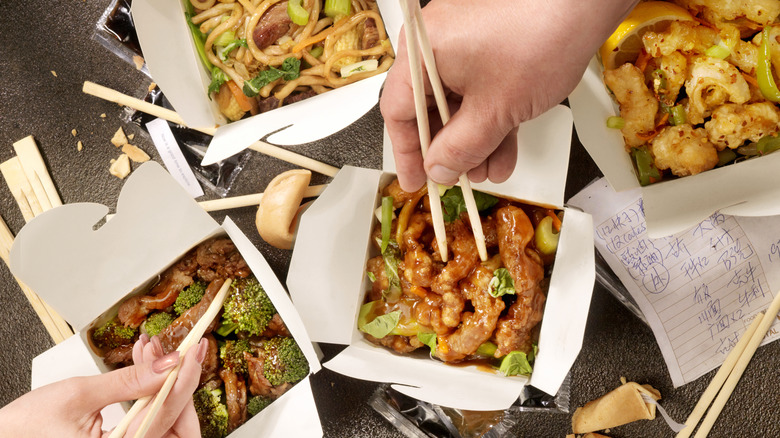The Difference Between British And American Chinese Takeout
Viral videos of British TikTokers unboxing food from Chinese takeout restaurants (called "takeaways" in England) caused consternation among Americans. Why? The hauls, which often included curry sauce, a dish referred to as "chicken balls," and french fries or "chips," look nothing like Chinese food in America — or in China. British Chinese cuisine is distinctly different from its American counterpart, from the food itself to the way people talk about it: Brits use the singular "a Chinese," shortened from "a Chinese meal," while Americans say that they're "getting Chinese," referencing "Chinese food" as a whole.
Writer Angela Hui was quick to comment, pointing out that British Chinese food — while bearing little resemblance to the food found in China — was the result of the hard work and innovation of Chinese immigrants. "[Takeaways] were the grassroots of many Chinese families including my own who came to this country with nothing," Hui tweeted. She would know: her memoir, "Takeaway: Stories from a Childhood Behind the Counter," recounts her childhood in her family's restaurant. Hui maintains that British Chinese cuisine is important in its own right, adding "I will fight anyone who thinks chicken balls are bad."
Americans can't judge. Many of the foods that Americans associate with Chinese takeout would seem out of place in China too. And, like Hui, some members of the Chinese diaspora have started to reclaim American Chinese cuisine as an extension of their identity. But why is British Chinese food so different from American? The answer lies in history.
What is British Chinese food?
British Chinese food represents a mishmash of history and identities. Some dishes have obvious Chinese origins, like old-school London classic jar jow, which is reportedly based on Beijing noodle sauce. Others, like chicken balls, have no obvious origin. The heavily battered, deep-fried lumps of chicken, often served with sweet and sour sauce, don't point to a specific cuisine.
Other dishes show a distinct fusion of cultures. Take salt and pepper chips, a takeaway staple. The "salt and pepper" in question is Chinese-style salt and pepper seasoning, which utilizes white pepper for a distinctly different flavor from the black pepper popular in the West. In addition to salt and pepper seasoning, the dish features British chips along with Chinese five-spice seasoning and sauteed vegetables. An ingenious combination of classic British street food and Chinese cuisine, the dish first originated in the 1900s. In Ireland, a similar dish called "spice bag" adds fried chicken. Chips doused in "Chinese curry" are also popular. Though curry isn't traditionally Chinese, takeaway shops likely adapted it from Indian cuisine to create something entirely new.
As in America, "authentic" Chinese cuisine has captured the attention of the British public in recent years. The Michelin-starred restaurant A. Wong offers a fine-dining tour through various regions of China, reflecting a trend towards a broader appreciation of Chinese cuisine. While traditional British Chinese cuisine was largely limited to Cantonese-style food, other regional cuisines, like Sichuanese, are gaining popularity.
What is American Chinese food?
In America, "Chinese food" brings to mind images of crab Rangoon, fortune cookies, chop suey, and General Tso's chicken in cardboard takeout boxes. But, none of these things are, strictly speaking, Chinese. General Tso's chicken (crispy fried chicken doused in a sweet and sour sauce) was invented by Hunanese chef Peng Chang-kuei.
Chang-kuei first developed the dish in China but introduced it to — and adapted it for — American tastes at his New York restaurant in the 1970s. No one knows for certain where chop suey (the ubiquitous mishmash of stir-fried meat, vegetables, and eggs) first developed, but Chinese American restaurants have made it their own. And, while fortune cookies aren't Chinese, they aren't American, either: historians believe that the cookies originated in Japan, where they're called "tsujiura senbei," or "fortune crackers."
American Chinese dishes often include ingredients that aren't widely available in China. Dairy products are rarely used in China, but deep-fried and cream cheese-filled crab Rangoon is found at Chinese restaurants across America. Broccoli is a common ingredient in American Chinese cuisine, found in dishes like broccoli beef and mixed into stir-fries, but American Chinese food features short, stubby American-style broccoli rather than the leafy stalks popular in China.
In the latter part of the 20th century, Americans became interested in "authentic" Chinese food after President Nixon visited China in 1972. With increased familiarity came increased demand, but American inventions like General Tso's chicken and crab rangoon still remain popular to this day.
Why is British Chinese food unique?
China has had a major impact on British cuisine since the 1600s when Britain first started importing tea from China, a development that forever changed British culture. But, it wasn't until the 1880s, when London's first Chinatown began to emerge around the Limehouse district, that Chinese food started to take off in Britain. The groceries and eateries in London's Chinatown originally catered to Chinese sailors and dockworkers but slowly started to draw outsiders too.
Around 1908, the first recorded Chinese restaurant opened in England: a London establishment called simply "The Chinese Restaurant." It was in the 1950s, however, that Chinese cuisine really took off in England. The U.K. relaxed its immigration laws after World War II in response to labor shortages, drawing an influx of Chinese families, many of whom opened restaurants. Some catered to the Chinese community while others sold popular British foods like buttered bread and pies alongside Westernized versions of Chinese dishes. These restaurants proved to be a hit with the British public, who quickly latched onto Chinese Takeaway dishes as a form of comfort food.
In recent years, American Chinese dishes like chop suey have gained a foothold in Britain, pushing British Chinese classics like jar jow into near extinction. But, holding onto the past of British Chinese cuisine goes against its very spirit. Food culture isn't static; it reflects the way that the immigrant experience changes over generations.
What makes American Chinese food unique?
When Chinese restaurants first began to appear in the United States in the 1800s, they largely catered to immigrants looking for a taste of home. Slandered in American newspapers as "unhygienic," these restaurants often struggled to stay afloat in a hostile environment. Over time, Chinese-American cuisine began to adapt. "Americanized" dishes let customers try something new and different but not too different.
Now, American Chinese cuisine has developed regional differences: people in the American South tend to welcome spicy flavors, while Northerners can't stand the heat. Chinese restaurants in New York cater to Jewish clientele by offering kosher food. In San Francisco, you might find mu shu wrappers made from tortillas.
Chinese American food has even earned the respect of Chinese citizens: Americanized Chinese restaurants have popped up in Shanghai and Beijing, drawing curious Chinese locals who've seen the food in movies and on TV. Fung Lam, who founded Shanghai's The Fortune Cookie with friend Dave Rossi, told the BBC that older Chinese people aren't always keen on the food — but younger folks often walk away impressed. Even among those who recognize its unique cultural contributions, the Chinese takeout food found in America and Britain is sometimes labeled "inauthentic." The complicated history — one closely tied to racism — can elicit mixed emotions. However, for some children of immigrant families, it represents a different kind of authenticity. If not authentic to China, it is authentic to the immigrant experience.
